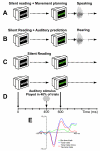Electrophysiological evidence for a general auditory prediction deficit in adults who stutter
- PMID: 26335995
- PMCID: PMC4663101
- DOI: 10.1016/j.bandl.2015.08.008
Electrophysiological evidence for a general auditory prediction deficit in adults who stutter
Abstract
We previously found that stuttering individuals do not show the typical auditory modulation observed during speech planning in nonstuttering individuals. In this follow-up study, we further elucidate this difference by investigating whether stuttering speakers' atypical auditory modulation is observed only when sensory predictions are based on movement planning or also when predictable auditory input is not a consequence of one's own actions. We recorded 10 stuttering and 10 nonstuttering adults' auditory evoked potentials in response to random probe tones delivered while anticipating either speaking aloud or hearing one's own speech played back and in a control condition without auditory input (besides probe tones). N1 amplitude of nonstuttering speakers was reduced prior to both speaking and hearing versus the control condition. Stuttering speakers, however, showed no N1 amplitude reduction in either the speaking or hearing condition as compared with control. Thus, findings suggest that stuttering speakers have general auditory prediction difficulties.
Keywords: Auditory cortex; Movement planning; Sensorimotor integration; Speech; Stuttering.
Copyright © 2015 Elsevier Inc. All rights reserved.
Figures



Similar articles
-
Limited Pre-Speech Auditory Modulation in Individuals Who Stutter: Data and Hypotheses.J Speech Lang Hear Res. 2019 Aug 29;62(8S):3071-3084. doi: 10.1044/2019_JSLHR-S-CSMC7-18-0358. Epub 2019 Aug 29. J Speech Lang Hear Res. 2019. PMID: 31465711 Free PMC article.
-
Modulation of auditory processing during speech movement planning is limited in adults who stutter.Brain Lang. 2015 Apr;143:59-68. doi: 10.1016/j.bandl.2015.03.002. Epub 2015 Mar 18. Brain Lang. 2015. PMID: 25796060 Free PMC article.
-
Stuttering adults' lack of pre-speech auditory modulation normalizes when speaking with delayed auditory feedback.Cortex. 2018 Feb;99:55-68. doi: 10.1016/j.cortex.2017.10.019. Epub 2017 Nov 13. Cortex. 2018. PMID: 29169049 Free PMC article.
-
Speech-Induced Suppression for Delayed Auditory Feedback in Adults Who Do and Do Not Stutter.Front Hum Neurosci. 2020 Apr 24;14:150. doi: 10.3389/fnhum.2020.00150. eCollection 2020. Front Hum Neurosci. 2020. PMID: 32390816 Free PMC article.
-
[Auditory speech-evoked cerebral cortex potentials in patients with stuttering syndromes].Laryngorhinootologie. 1998 Dec;77(12):709-14. doi: 10.1055/s-2007-997228. Laryngorhinootologie. 1998. PMID: 10036674 Review. German.
Cited by
-
Does pre-speech auditory modulation reflect processes related to feedback monitoring or speech movement planning?bioRxiv [Preprint]. 2024 Jul 13:2024.07.13.603344. doi: 10.1101/2024.07.13.603344. bioRxiv. 2024. Update in: Neurosci Lett. 2024 Nov 20;843:138025. doi: 10.1016/j.neulet.2024.138025. PMID: 39026879 Free PMC article. Updated. Preprint.
-
Limited Pre-Speech Auditory Modulation in Individuals Who Stutter: Data and Hypotheses.J Speech Lang Hear Res. 2019 Aug 29;62(8S):3071-3084. doi: 10.1044/2019_JSLHR-S-CSMC7-18-0358. Epub 2019 Aug 29. J Speech Lang Hear Res. 2019. PMID: 31465711 Free PMC article.
-
Multimodal explainable AI predicts upcoming speech behavior in adults who stutter.Front Neurosci. 2022 Aug 1;16:912798. doi: 10.3389/fnins.2022.912798. eCollection 2022. Front Neurosci. 2022. PMID: 35979337 Free PMC article.
-
Sex differences in early sensorimotor processing for speech discrimination.Sci Rep. 2019 Jan 23;9(1):392. doi: 10.1038/s41598-018-36775-5. Sci Rep. 2019. PMID: 30674942 Free PMC article. Clinical Trial.
-
Perceptual formant discrimination during speech movement planning.bioRxiv [Preprint]. 2023 Oct 11:2023.10.11.561423. doi: 10.1101/2023.10.11.561423. bioRxiv. 2023. Update in: PLoS One. 2024 Apr 2;19(4):e0301514. doi: 10.1371/journal.pone.0301514. PMID: 37873157 Free PMC article. Updated. Preprint.
References
-
- Baess P, Horvath J, Jacobsen T, Schroeger E. Selective suppression of self-initiated sounds in an auditory stream: An ERP study. Psychophysiology. 2011;48(9):1276–1283. doi:10.1111/j.1469-8986.2011.01196.x. - PubMed
-
- Baess P, Jacobsen T, Schroger E. Suppression of the auditory N1 event-related potential component with unpredictable self-initiated tones: Evidence for internal forward models with dynamic stimulation. International Journal of Psychophysiology. 2008;70(2):137–143. - PubMed
Publication types
MeSH terms
Grants and funding
LinkOut - more resources
Full Text Sources
Other Literature Sources
Medical

